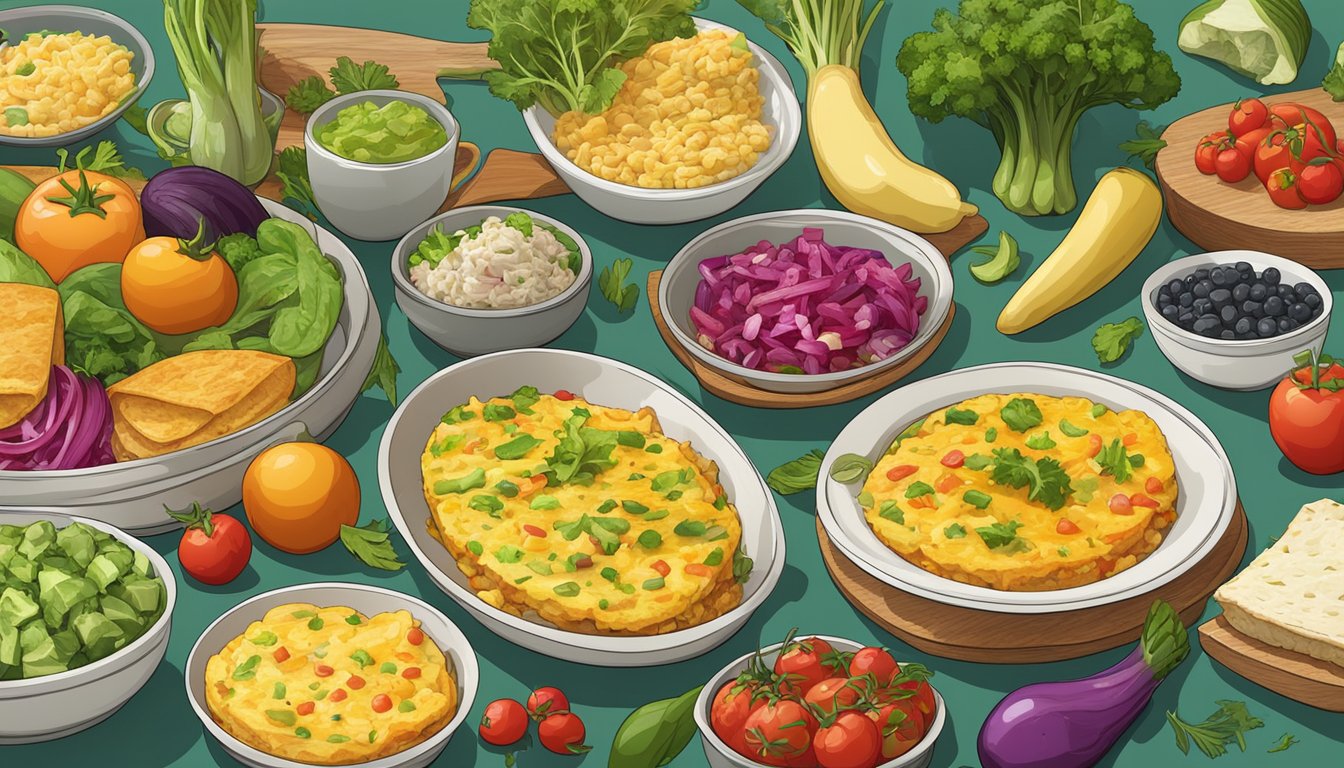Leftover vegetables often end up forgotten in the refrigerator, but they can be transformed into delicious breakfast dishes. By incorporating these nutritious ingredients into morning meals, home cooks can reduce food waste and start their day with a healthy boost. These recipes offer creative ways to use up extra veggies while adding flavor and nutrients to breakfast favorites.
From frittatas and omelets to smoothies and breakfast burritos, there are numerous options for incorporating leftover vegetables into the first meal of the day. By repurposing vegetables in breakfast recipes, individuals can save time and money while enjoying satisfying and nourishing meals. These dishes provide an excellent opportunity to increase vegetable consumption and add variety to morning routines.
1) Vegetable Frittata

Vegetable frittatas are an excellent way to use up leftover vegetables from the previous night’s dinner. This versatile dish can incorporate a wide variety of vegetables, making it a perfect choice for cleaning out the refrigerator.
To create a frittata, start by whisking eggs with a touch of cream or yogurt for added richness. Mix in shredded cheese, salt, and pepper for flavor. Heat olive oil in an oven-safe skillet and sauté any leftover vegetables until they soften.
Pour the egg mixture over the vegetables and cook on low heat until the edges begin to set. Transfer the skillet to a preheated oven and broil for a few minutes until the top is golden brown and puffy.
Common vegetables that work well in frittatas include onions, bell peppers, zucchini, asparagus, and mushrooms. For a unique twist, try incorporating kale raab or collard green buds when available at farmers’ markets.
Frittatas can be served hot or at room temperature, making them ideal for busy mornings or weekend brunches. They also reheat well, providing a quick and nutritious breakfast option throughout the week.
2) Root Vegetable Hash

Root vegetable hash is a versatile breakfast dish that transforms leftover vegetables into a flavorful morning meal. This hearty dish combines diced root vegetables like potatoes, sweet potatoes, carrots, and beets.
To prepare, heat oil in a skillet over medium heat. Add the diced vegetables and cook until they begin to brown, stirring occasionally. For extra flavor, include aromatic ingredients like onions or garlic.
Season the hash with salt, pepper, and herbs such as rosemary or thyme. Cook until the vegetables are tender and crispy on the outside. This process usually takes about 15-20 minutes.
For added protein, create wells in the hash and crack eggs directly into them. Cover the skillet and cook until the eggs reach desired doneness. Alternatively, serve the hash topped with fried or poached eggs.
This dish can be customized based on available leftovers. Parsnips, turnips, or rutabagas work well in the mix. For a complete meal, consider adding leafy greens like kale or spinach during the last few minutes of cooking.
3) Spinach and Tomato Omelette
A spinach and tomato omelette offers a delicious way to use leftover vegetables for breakfast. This protein-packed dish combines nutrient-rich spinach with juicy tomatoes in a fluffy egg base.
To prepare, whisk eggs with a splash of milk, salt, and pepper. Heat olive oil in a non-stick skillet over medium heat. Add chopped spinach and diced tomatoes, cooking until the spinach wilts.
Pour the egg mixture over the vegetables, tilting the pan to spread evenly. As the eggs set, gently lift the edges to allow uncooked egg to flow underneath.
When the omelette is mostly set, add cheese if desired. Carefully fold one half of the omelette over the other. Cook for an additional minute to melt the cheese and finish cooking the eggs.
Slide the omelette onto a plate and serve immediately. This versatile recipe can accommodate various leftover vegetables, making it an excellent choice for reducing food waste while enjoying a nutritious breakfast.
4) Vegetable Breakfast Burrito

Vegetable breakfast burritos offer a delicious way to use leftover vegetables. These versatile wraps can incorporate a variety of ingredients, making them perfect for clearing out the fridge.
Common vegetables used in breakfast burritos include bell peppers, onions, and tomatoes. Leftover roasted vegetables, such as sweet potatoes or zucchini, can also be added for extra flavor and texture.
To prepare the filling, scrambled eggs are often combined with sautéed vegetables. Black beans or refried beans can be included for added protein and fiber. Some recipes suggest cooking hash browns to add a crispy element.
The vegetable and egg mixture is then wrapped in a large tortilla, typically whole wheat for added nutrition. Cheese is often sprinkled on top before rolling for a gooey, melty interior.
For extra flavor, spices like taco seasoning can be added to the vegetables or beans. Fresh cilantro and a squeeze of lime juice can brighten up the flavors.
These burritos can be made ahead and frozen for quick weekday breakfasts. To reheat, simply microwave or warm in the oven until heated through.
5) Zucchini Pancakes
Zucchini pancakes offer a delicious way to use leftover zucchini for breakfast. These savory pancakes combine grated zucchini with a simple batter for a nutritious and flavorful morning meal.
To make zucchini pancakes, grate fresh zucchini and mix it with flour, eggs, and seasonings. Some recipes include additional ingredients like onions, garlic, or cheese for extra flavor.
The batter is then cooked on a griddle or in a pan, similar to traditional pancakes. They’re typically fried until golden brown on both sides, resulting in a crispy exterior and tender interior.
Zucchini pancakes can be served with various toppings. Some prefer them with sour cream or yogurt, while others opt for applesauce or a drizzle of maple syrup.
These pancakes are versatile and can be customized to suit different tastes. Adding herbs like dill or basil can enhance the flavor profile. For a gluten-free option, alternative flours can be used in place of wheat flour.
Zucchini pancakes not only taste great but also provide a clever way to incorporate vegetables into breakfast. They’re a practical solution for using up excess zucchini from the garden or fridge.
6) Carrot Muffins
Carrot muffins offer a delicious way to incorporate leftover shredded carrots into a breakfast treat. These moist and flavorful muffins combine the sweetness of carrots with warm spices like cinnamon and nutmeg.
To make carrot muffins, one typically mixes flour, baking powder, sugar, and spices in a bowl. In a separate bowl, eggs, oil, and milk are whisked together before being combined with the dry ingredients.
Shredded carrots are then folded into the batter. For added texture and flavor, some recipes include chopped nuts, raisins, or grated apple. The batter is spooned into a greased muffin tin and baked at around 375°F (190°C) for about 20 minutes.
These muffins can be customized to suit various dietary needs. Whole wheat flour can be substituted for a heartier texture, while applesauce can replace some of the oil for a lighter version.
Carrot muffins make for a convenient grab-and-go breakfast option. They can be prepared in advance and stored in an airtight container for several days, making them ideal for busy mornings.
7) Potato and Swiss Chard Breakfast Skillet

This hearty breakfast skillet combines leftover potatoes and Swiss chard for a nutritious start to the day. The dish incorporates tender potato slices with vibrant Swiss chard leaves, creating a colorful and flavorful meal.
To prepare, cook bacon pieces in a large skillet until crispy. Remove the bacon, leaving a small amount of grease in the pan. Add thinly sliced potatoes and cook until they begin to soften.
Next, introduce chopped Swiss chard to the skillet. The leafy greens will wilt quickly, adding a pop of color and nutrients to the dish. For extra flavor, include diced onions and garlic.
Return the bacon to the pan and stir to combine all ingredients. Some cooks may choose to add cheese on top, allowing it to melt under the broiler for a few minutes.
This versatile recipe can be customized with additional vegetables like bell peppers or mushrooms. For a vegetarian version, omit the bacon and use olive oil instead.
The result is a satisfying breakfast skillet that makes excellent use of leftover vegetables, transforming them into a delicious morning meal.
8) Kale and Pepper Quiche

Kale and pepper quiche is a versatile breakfast dish that transforms leftover vegetables into a delicious meal. This savory creation combines nutrient-rich kale with colorful bell peppers in a creamy egg custard.
To prepare, sauté chopped kale and sliced peppers until tender. A mix of red, yellow, and green peppers adds visual appeal and varied flavors. Whisk eggs with milk or cream, then add salt and pepper to taste.
Pour the egg mixture over the vegetables in a pre-baked pie crust. For a lighter option, skip the crust and make a crustless quiche. Sprinkle shredded cheese on top for extra richness.
Bake the quiche until golden brown and set in the center. The cooking time typically ranges from 35 to 45 minutes at 375°F (190°C). Let it cool slightly before slicing and serving.
This quiche can be enjoyed hot, warm, or at room temperature. It pairs well with a simple side salad or fresh fruit for a complete breakfast or brunch. Leftovers reheat nicely, making it an excellent make-ahead meal option.
9) Roasted Vegetable Breakfast Bowl
Roasted vegetable breakfast bowls offer a delicious way to use leftover roasted vegetables. This versatile dish combines warm, caramelized veggies with protein-rich eggs and optional toppings for a satisfying morning meal.
Start by reheating leftover roasted vegetables in the oven at 350°F for 10-15 minutes or in a skillet over medium heat. Common choices include sweet potatoes, broccoli, and red onions.
While the vegetables warm up, prepare eggs to your liking – scrambled, fried, or poached. For added flavor, sprinkle some shredded cheddar cheese over the eggs as they cook.
Assemble the bowl by placing the reheated roasted vegetables as the base. Top with the cooked eggs and cheese. For extra protein, consider adding pre-cooked veggie sausage, heated according to package instructions.
Customize your bowl with additional toppings like avocado slices, salsa, or a dollop of Greek yogurt. A sprinkle of fresh herbs or a drizzle of hot sauce can add an extra flavor boost.
This breakfast bowl is not only tasty but also nutrient-dense, providing a balanced mix of vegetables, protein, and healthy fats to start your day.
10) Spinach and Mushroom Crepes
Spinach and mushroom crepes offer a delicious way to use leftover vegetables for breakfast. This savory dish combines the earthiness of mushrooms with the nutritious punch of spinach.
To prepare the crepes, whisk together flour, milk, eggs, melted butter, and salt. Let the batter rest in the refrigerator for 30 minutes before cooking.
For the filling, sauté sliced mushrooms in a pan until golden brown. Add baby spinach and cook until wilted. Season the mixture with herbs and spices to taste.
Cook the crepes in a non-stick skillet, then fill each one with the mushroom and spinach mixture. Sprinkle some gruyere cheese on top for added flavor.
Fold the crepes and serve them warm. This versatile recipe can be customized with different cheeses or additional vegetables to suit individual preferences.
Spinach and mushroom crepes provide a balanced breakfast option that is both satisfying and nutritious. They can be prepared in advance and reheated for busy mornings.
11) Sweet Potato and Black Bean Breakfast Tacos
Sweet potato and black bean breakfast tacos offer a delicious way to use leftover sweet potatoes. This vibrant dish combines the sweetness of roasted sweet potatoes with the earthy flavor of black beans.
To prepare, cook diced sweet potatoes in a skillet with oil until tender and slightly crispy. Add bell peppers and onions for extra flavor and nutrition. Season the mixture with chili powder, salt, and pepper to taste.
In a separate pan, warm black beans with preferred spices. Heat tortillas and assemble the tacos by layering the sweet potato mixture and beans. For added protein, scrambled or fried eggs can be included.
These tacos are customizable and can be topped with avocado, salsa, or a dollop of Greek yogurt. They provide a balanced meal with complex carbohydrates, protein, and fiber.
This recipe is ideal for meal prep, as the components can be prepared in advance and quickly assembled in the morning. It’s a nutritious and satisfying breakfast option that makes good use of leftover vegetables.
12) Beet and Citrus Smoothie

This vibrant smoothie combines the earthy sweetness of beets with the bright flavors of citrus fruits. It’s an excellent way to use leftover cooked beets from dinner.
The smoothie packs a nutritional punch with antioxidants from both beets and citrus. Beets offer anti-inflammatory properties, while citrus fruits provide vitamin C.
To make the smoothie, blend cooked beets with orange segments, a squeeze of lime juice, and a splash of coconut milk. For added sweetness, a pitted date can be included.
The result is a creamy, pink-hued drink that tastes refreshing rather than “earthy.” The citrus helps balance the beet flavor, creating a harmonious blend.
This smoothie works well as a quick breakfast or post-workout refuel. It can be prepared in advance and stored in the refrigerator for up to 24 hours.
For extra nutrition, a handful of spinach can be added without significantly altering the taste. The greens will blend seamlessly with the other ingredients.
13) Cabbage Stir-Fry with Eggs
Cabbage stir-fry with eggs is a quick and nutritious breakfast option that makes excellent use of leftover vegetables. This dish combines crisp cabbage with protein-rich eggs for a satisfying start to the day.
To prepare, heat oil in a large skillet over medium heat. Add diced leftover cabbage and stir-fry for a few minutes until it begins to soften. Push the cabbage to one side of the pan and crack eggs into the empty space.
Scramble the eggs as they cook, gradually incorporating them with the cabbage. Season with salt and pepper to taste. For added flavor, consider including other leftover vegetables like carrots or bell peppers.
The cooking process is brief, typically taking no more than 5-7 minutes. This ensures the cabbage retains some crunch while the eggs are fully cooked. Serve the stir-fry hot, optionally garnished with chopped green onions or a dash of soy sauce.
This versatile recipe can be adapted to suit individual preferences. Some may choose to add a pinch of red pepper flakes for heat or a splash of sesame oil for a nutty aroma.
14) Stuffed Bell Peppers Omelette
This breakfast dish repurposes leftover stuffed bell peppers into a flavorful omelette. Start by chopping the leftover peppers into small pieces, including the filling.
In a bowl, whisk together eggs, milk, salt, and pepper. Heat a non-stick pan over medium heat and add a small amount of butter or oil.
Pour the egg mixture into the pan and let it cook until the edges begin to set. Sprinkle the chopped stuffed peppers over one half of the omelette.
As the eggs continue to cook, use a spatula to gently lift the edges, allowing uncooked egg to flow underneath. When the omelette is mostly set but still slightly wet on top, fold the empty half over the pepper-filled side.
Cook for another minute or two until the cheese melts and the eggs are fully cooked. Slide the omelette onto a plate and serve immediately.
This dish combines the savory flavors of stuffed peppers with the classic breakfast favorite, creating a satisfying and protein-rich meal to start the day.
15) Sweet Corn Muffins

Sweet corn muffins offer a delicious way to use leftover vegetables in a breakfast treat. These muffins incorporate corn kernels for added texture and flavor.
To make sweet corn muffins, combine flour, cornmeal, sugar, baking powder, and salt in a bowl. In a separate bowl, whisk together eggs, milk, oil, and sour cream.
Mix the wet ingredients into the dry ingredients until just combined. Fold in thawed corn kernels for extra sweetness and texture.
Preheat the oven to 400°F (200°C). Grease a muffin tin or line it with cupcake liners. Fill each cup about 3/4 full with batter.
Bake the muffins for 20-22 minutes, or until a toothpick inserted into the center comes out clean. Allow them to cool in the pan for 5 minutes before transferring to a wire rack.
These muffins make an excellent breakfast option, pairing well with butter, honey, or jam. They can also be served as a side dish for savory breakfast items.
Health Benefits of Using Leftover Vegetables
Incorporating leftover vegetables into breakfast recipes offers significant nutritional advantages and helps reduce food waste. These benefits contribute to both personal health and environmental sustainability.
Nutritional Value
Leftover vegetables retain much of their nutritional content when properly stored and reheated. They provide essential vitamins, minerals, and fiber that support overall health. For example, spinach and kale offer iron and vitamin K, while bell peppers are rich in vitamin C.
Vegetables add bulk and nutrients to breakfast dishes without excessive calories. This helps maintain a healthy weight and provides sustained energy throughout the morning.
Combining vegetables with protein sources like eggs or Greek yogurt creates balanced meals. This combination supports muscle health and helps regulate blood sugar levels.
Reducing Food Waste
Using leftover vegetables in breakfast recipes significantly reduces household food waste. This practice saves money and conserves resources used in food production and transportation.
Repurposing vegetables extends their usable life, maximizing the nutritional value obtained from each purchase. It also encourages more frequent consumption of vegetables, contributing to improved dietary habits.
By incorporating leftovers into meals, families can reduce their environmental impact. This habit decreases the amount of organic waste sent to landfills, lowering greenhouse gas emissions associated with food decomposition.
Tips for Preparing Vegetables for Breakfast

Incorporating vegetables into breakfast dishes requires proper preparation and selection. The right techniques can enhance flavors and textures while maximizing nutritional benefits.
Choosing the Right Vegetables
Select vegetables that complement breakfast flavors and cook quickly. Leafy greens like spinach and kale are versatile and nutrient-dense. Bell peppers, tomatoes, and mushrooms add vibrant colors and umami flavors.
Opt for pre-washed and chopped vegetables to save time in the morning. Frozen vegetables can be convenient and nutritious alternatives.
Consider texture when choosing vegetables. Zucchini and carrots can be grated into batters or mixed into scrambles. Roasted sweet potatoes or squash add heartiness to breakfast bowls.
Storage and Freshness
Store vegetables properly to maintain freshness and extend shelf life. Keep most vegetables in the crisper drawer of the refrigerator.
Wrap leafy greens in paper towels before storing to absorb excess moisture. Store herbs upright in water, like flowers in a vase, to keep them fresh longer.
Prep vegetables in advance for quick assembly in the morning. Wash, chop, and store in airtight containers for up to 3-4 days.
Blanch vegetables before freezing to preserve color, texture, and nutrients. This technique works well for broccoli, cauliflower, and green beans.
Use the “first in, first out” method to rotate vegetables and minimize waste. Check for signs of spoilage regularly and remove any damaged produce.




